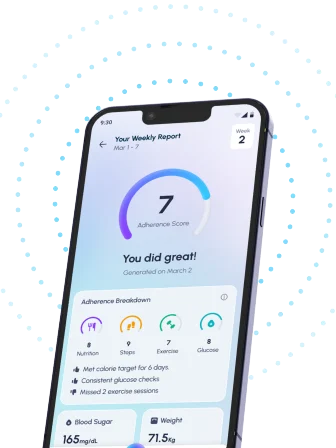Table of Contents
- Winter Blues and Diabetes: A Comprehensive Guide
- Conquering Seasonal Affective Disorder with Diabetes
- Diabetes Management During the Winter Months
- Combating SAD and Diabetes: Tips and Strategies
- Is Your Diabetes Worse in Winter? Understanding the Link to SAD
- Frequently Asked Questions
- References
Winter’s arrival often brings shorter days, colder temperatures, and for many, a dip in mood. But if you’re living with diabetes, the seasonal slump can feel even more challenging. This blog post tackles Conquering the Winter Blues: Diabetes and Seasonal Affective Disorder (SAD), exploring the connection between these two conditions and offering practical strategies to help you manage both your diabetes and your mental well-being during the darker months. We’ll delve into how SAD can impact blood sugar control and provide helpful tips to boost your mood and stay healthy throughout the winter. Let’s face the season head-on together!
Winter Blues and Diabetes: A Comprehensive Guide
While often associated with colder climates, the “winter blues,” or Seasonal Affective Disorder (SAD), can impact individuals in tropical and Indian regions experiencing monsoon seasons or periods of reduced sunlight. This is particularly crucial for those managing diabetes. Research suggests a significant link between diabetes and an increased risk of sleep disorders, including sleep apnea, by as much as 70%. This disruption in sleep can exacerbate symptoms of SAD, creating a challenging interplay between physical and mental health. The reduced sunlight during these periods can disrupt circadian rhythms, affecting blood sugar regulation and increasing the risk of complications for people with diabetes.
Understanding the Connection
The connection between SAD and diabetes isn’t simply about feeling down. Disrupted sleep, a common symptom of both SAD and sleep apnea (a condition strongly linked to diabetes), leads to hormonal imbalances, affecting insulin sensitivity and blood glucose control. Consequently, managing blood sugar levels becomes more challenging, potentially increasing the risk of hyperglycemia (high blood sugar) or hypoglycemia (low blood sugar). This can further impact mood and energy levels, creating a vicious cycle. Furthermore, the emotional distress associated with SAD can lead to poor dietary choices, impacting blood sugar control. For practical tips on managing blood sugar levels during the winter months, check out our guide, Winter Tips for Managing Blood Sugar Levels.
Practical Tips for Indian & Tropical Climates
Even in warmer climates, ensuring adequate sunlight exposure is vital. Try to spend at least 15-20 minutes outdoors daily, especially during the sunniest parts of the day. Prioritizing regular physical activity, maintaining a balanced diet, and practicing stress-management techniques like yoga or meditation are crucial for managing both diabetes and SAD symptoms. Consulting with a doctor or a diabetes specialist is recommended for personalized advice and to address any concerns. Regular check-ups are essential to monitor blood sugar levels and overall health during these challenging months. Remember, proactive management is key to enjoying a healthy and balanced life, regardless of the season. For additional advice on controlling your blood sugar during winter, you might find our article Winter Tips for Controlling Blood Sugar Levels helpful.
Conquering Seasonal Affective Disorder with Diabetes
Seasonal Affective Disorder (SAD) can significantly impact mental well-being, and for individuals with diabetes, managing this alongside blood sugar control presents unique challenges. The global economic burden of diabetes, estimated at $760 billion annually, underscores the importance of holistic health management, including addressing mental health concerns like SAD. In tropical and Indian climates, while the impact of SAD might be less pronounced than in regions with extreme seasonal variations, subtle shifts in mood and energy levels can still affect diabetes management.
Recognizing SAD Symptoms in Tropical Climates
While the classic SAD symptoms of lethargy, weight gain, and food cravings are relevant, in warmer climates, individuals might experience a decreased appetite, irritability, and sleep disturbances. These can subtly impact blood sugar control, making consistent monitoring and adherence to treatment plans even more crucial. Recognizing these subtle changes is key to proactive management.
Practical Strategies for Managing SAD and Diabetes
Maintaining a regular exercise routine is vital, even in warmer weather. Prioritize activities that you enjoy, whether it’s a morning walk, yoga, or swimming. A balanced diet rich in fruits, vegetables, and whole grains is essential for both physical and mental health. Moreover, consider incorporating mindfulness techniques like meditation or deep breathing exercises to manage stress and improve mood. Seeking support from a healthcare professional, including a mental health specialist, is crucial for personalized advice and treatment. Understanding how to address emotional eating, a common symptom of SAD, is also vital for maintaining blood sugar control.
Seeking Support in India and Tropical Countries
Access to mental health services varies across India and other tropical countries. It’s essential to identify local resources and support groups to help manage both diabetes and SAD. Open communication with your doctor about your mental well-being is crucial, ensuring a holistic approach to your overall health. Remember, proactive management of both physical and mental health contributes significantly to a better quality of life. As you age, the challenges of managing diabetes can increase, so it’s important to be prepared. Learn more about managing diabetes as you age.
Diabetes Management During the Winter Months
Combating the Winter Blues and Blood Sugar Fluctuations
While winter may bring festive cheer to many, it can present unique challenges for individuals managing diabetes, particularly in tropical and Indian climates where seasonal changes might be less dramatic but still impact routines. The shorter days and reduced sunlight can lead to decreased physical activity and increased cravings for comfort foods – factors that can significantly affect blood sugar levels. This is especially relevant considering that a significant portion of the diabetic population, 61% of whom are aged between 20-64 years, according to the IDF Diabetes Atlas, are in their prime working years and may face added stress during this period. For the older demographic (39% aged 65+ years), the impact of fluctuating temperatures and reduced mobility can be even more pronounced.
Prioritizing Healthy Habits During the Festive Season
In regions like India, winter festivities often involve rich, high-carbohydrate foods. Maintaining consistent blood sugar levels requires careful planning and mindful choices. Prioritize regular physical activity, even if it’s just a short walk in the sun. This is crucial in combating the winter blues and promoting overall well-being. Pay close attention to portion sizes and opt for healthier alternatives when indulging in festive meals. Consult your doctor or a certified diabetes educator for personalized dietary advice tailored to your needs and regional food culture. Remember, consistent monitoring of blood sugar levels remains essential throughout the winter months. For more effective management strategies, check out our guide on 10 Proven Tips for Effective Diabetes Management.
Staying Healthy & Proactive in India and Tropical Countries
The impact of winter on diabetes management may be less severe in warmer climates, but maintaining consistent blood glucose levels is still vital. Regular check-ups with your doctor and adherence to your treatment plan are key to preventing complications. Connect with local diabetes support groups for peer support and advice tailored to the specific challenges faced in your region. Taking proactive steps to manage your diabetes during the winter months will empower you to enjoy the festive season while prioritizing your health. Strengthening your immune system is also crucial; learn more about Boosting Immunity While Managing Diabetes.
Combating SAD and Diabetes: Tips and Strategies
The shorter days and colder weather of winter can trigger Seasonal Affective Disorder (SAD), impacting mood and energy levels. For individuals with diabetes, this can present additional challenges, potentially affecting blood sugar management and overall well-being. It’s crucial to remember that up to 80% of Type 2 diabetes cases can be delayed or prevented through lifestyle changes, making proactive management of both SAD and diabetes even more important. This is especially relevant in Indian and tropical countries where the shift in seasons, while perhaps less dramatic than in temperate climates, can still impact mental and physical health.
Managing Blood Sugar During Winter
Winter’s impact on diabetes management often involves increased cravings for comfort foods, which are frequently high in carbohydrates and sugars. This can lead to blood sugar spikes and fluctuations, making consistent monitoring and adherence to your diabetes management plan even more critical. Prioritize regular exercise, even if it’s just a short walk in the sun each day. This helps regulate blood sugar and boosts mood, counteracting SAD symptoms. Consider incorporating activities you enjoy, like yoga or dance, to improve adherence. For more tips on effective diabetes management, check out our guide: 10 Proven Tips to Effectively Manage Diabetes | Simple Guide.
Combating SAD Symptoms
In addition to managing diabetes, actively addressing SAD symptoms is crucial. Increase exposure to sunlight, even if it’s just for 15-20 minutes daily. This can significantly improve mood and energy levels. In tropical climates, this might mean seeking out shaded areas to avoid overheating while still receiving sunlight. Consider incorporating light therapy boxes, which mimic natural sunlight, if sunlight exposure is limited. Prioritizing sleep hygiene and maintaining a balanced diet rich in fruits, vegetables, and whole grains will also support both your physical and mental health. Remember that a healthy lifestyle contributes significantly to preventing and managing Type 2 diabetes. Managing stress is also incredibly important, and can significantly impact your blood sugar levels. Learning Effective Stress Management Tips for Better Diabetes Control can be beneficial.
Seeking Support in Indian and Tropical Countries
Don’t hesitate to seek support from your doctor or a mental health professional if you’re struggling with SAD or are finding diabetes management challenging during the winter months. Many resources and support groups are available in Indian and tropical countries, offering guidance and community. Remember, proactive management is key to a healthier and happier winter season.
Is Your Diabetes Worse in Winter? Understanding the Link to SAD
The shorter days and colder temperatures of winter can significantly impact our well-being, and for individuals with diabetes, this impact can be particularly pronounced. While the winter blues are a common experience, the connection between Seasonal Affective Disorder (SAD) and diabetes management is often overlooked, especially in warmer, tropical climates like those found in India. Research shows that women with diabetes face a 40% higher risk of heart disease compared to men with diabetes, highlighting the importance of proactive health management year-round, but particularly during challenging seasons. This increased risk underscores the need for extra vigilance in winter months.
The Winter-Diabetes Connection: More Than Just the Blues
Experiencing SAD symptoms like lethargy, decreased motivation, and increased appetite can disrupt established diabetes management routines. The tendency towards comfort eating, often involving high-carbohydrate foods, can lead to increased blood sugar levels. Furthermore, reduced physical activity due to the cold weather or lower mood can negatively impact blood glucose control. This is true regardless of geographic location, though the impact might be felt differently in tropical climates where the temperature change is less drastic, but the shift in daylight hours can still affect mood and routines. It’s interesting to compare this to the effects of hot weather, as described in our article on How Does Hot Weather Affect Diabetes?.
Managing Diabetes and SAD in Tropical Climates
Even in warmer regions of India, the shorter days can still impact mental well-being and subsequently, diabetes management. Prioritizing consistent blood glucose monitoring is crucial throughout the winter months. Maintaining a healthy diet rich in seasonal fruits and vegetables, even in tropical climates, remains vital. Moreover, finding ways to incorporate even small amounts of daily physical activity, such as mindful walks in the sun, can significantly improve mood and glucose control. Consider seeking support from healthcare professionals for personalized advice on managing diabetes during the winter season. Remember, staying proactive and informed is key to navigating the challenges posed by SAD and maintaining optimal diabetes management. Understanding the complications of diabetes, such as Peripheral Artery Disease (PAD), is also crucial for proactive management.
Frequently Asked Questions on Conquering the Winter Blues: Diabetes and Seasonal Affective Disorder
Q1. How does Seasonal Affective Disorder (SAD) affect people with diabetes?
SAD can worsen blood sugar control and mental well-being in individuals with diabetes. Disrupted sleep, a common symptom of both SAD and sleep apnea (often linked to diabetes), leads to hormonal imbalances that affect insulin sensitivity. The reduced sunlight in winter disrupts circadian rhythms, further impacting blood sugar regulation.
Q2. What are the best strategies for managing diabetes during the winter months?
Consistent blood glucose monitoring is crucial. Maintain a balanced diet, engage in regular exercise, and practice stress management techniques such as yoga or meditation. Be mindful of increased cravings for comfort foods, which can cause blood sugar spikes, and practice portion control.
Q3. Can SAD affect diabetics even in tropical climates?
Yes, while SAD is more prevalent in areas with less sunlight, its effects on sleep, mood, and therefore blood sugar control, can still impact individuals with diabetes in tropical climates.
Q4. What kind of support is available for managing diabetes and SAD?
It’s essential to seek personalized advice from healthcare professionals. Local diabetes support groups can also provide valuable support and connection with others facing similar challenges.
Q5. What are the key proactive steps to mitigate the effects of SAD on my diabetes management?
Proactive management is key. This includes consistent monitoring of blood sugar levels, maintaining a healthy lifestyle through diet and exercise, managing stress effectively, and seeking support from healthcare providers and support groups to create a holistic management plan.
References
- A Practical Guide to Integrated Type 2 Diabetes Care: https://www.hse.ie/eng/services/list/2/primarycare/east-coast-diabetes-service/management-of-type-2-diabetes/diabetes-and-pregnancy/icgp-guide-to-integrated-type-2.pdf
- Your Guide to Diabetes: Type 1 and Type 2: https://www.niddk.nih.gov/-/media/Files/Diabetes/YourGuide2Diabetes_508.pdf




